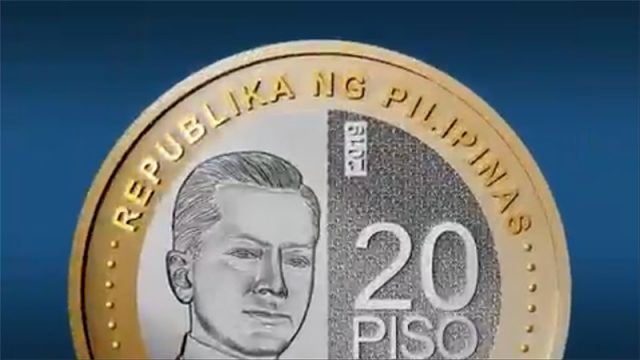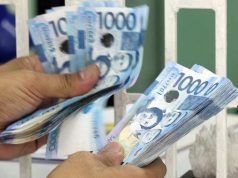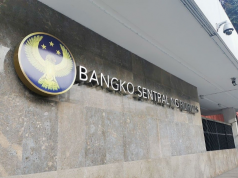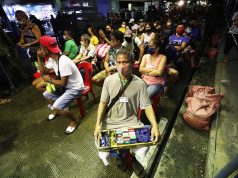
The design of the P20 coin by the Bangko Sentral ng Pilipinas may prove problematic for those with impaired eyesight as it can be difficult to distinguish from other coins.
“Hindi niyo ba naisip na baka mahirapan mga senior citizen lalo (na) pagdating sa pera kasi pare-pareho halos yung mga barya?” a Twitter user asked.
BSP on Tuesday unveiled the new P20 coin along with the redesigned version of the P5 coin to be released in circulation early next year.
The P20 coin takes the place of P10 as the highest denomination in the central bank’s New Generation Currency coin series.
It retains most of the elements from the banknote version, with the face of Commonwealth-era President Manuel L. Quezon on the coin’s front side.
The reverse side features the logo of the BSP and the Malacañan Palace, the country’s seat of power.
The P20 coin also features the design of the Nilad, a plant in which the name of Manila is believed to have come from. This is in accordance with the designs of the coin series that displays native flora on the reverse side.
The new coin also has microprint and an identifiable edge that make it difficult for counterfeiters to replicate.
The enhanced P5 coin, meanwhile, is heavier, thicker and has nine sides to supposedly make it look more distinct than other silver coins.
The BSP said it introduced the P20 coin since it is “more cost-efficient to produce as it will have a longer circulation life” than its banknote version.
#BSP Releases New 20-Piso and Enhanced 5-Piso Coinshttps://t.co/nsF19ILSSV pic.twitter.com/VNVlBMYcK8
— Bangko Sentral (@BangkoSentral) December 17, 2019
It also cited a study by the University of the Philippines which revealed that P20 is the “most-used denomination for payments across the country,” according to the central monetary authority.
“As a result, it is easily rendered unfit for circulation and returned to the BSP for replacement,” BSP said in a statement.
BSP Assistant Governor Dahlia Luna remarked that the lifespan of the P20 coin is longer than the banknote version, hence its rollout.
“The lifespan of a coin when re-circulated is more than 10 to 15 years compared to banknotes, which is less than one year,” she said last June.
Concerns
The introduction of a P20 coin, however, did not impress some Filipinos who commented those with poor eyesight may not be able to distinguish the silver coins from one another.
“Sir, we really don’t need a 20 peso coin—especially not when we can’t even distinguish the existing ones from each other,” wrote another Twitter user.
“Kumusta naman yung mga may edad or may poor eyesight na Filipinos? Hirap na nga nila ma-distinguish kung alin ang 1,5 at 10’s, dadagdagan pa ng 20 peso coins,” wrote another Twitter user.
A user said that the BSP could’ve thought of ways to make banknotes “more durable” instead of releasing new coins.
Look, i get their perspective of making 20 peso bills into coins will make them more durable,,pero kasi ang unnecessary? sooo difficult to distinguish from other peso coins like,,hindi siya user friendly…they couldve came up w a material that will help paper bills durable diba? https://t.co/FNpYi5mjGq
— sam☻ (@FlNDtheSAM) December 17, 2019
“Look, I get their perspective of making 20 peso bills into coins will make them more durable, pero kasi ang unnecessary? Sooo difficult to distinguish from other peso coins like, hindi siya user-friendly… they could’ve come up with a material that will help paper bills durable ‘di ba?” she wrote.
Today’s P1, P5 and P10 coins all share the same color of silver.
While P1 is smaller, the shape of the P5 and P10 coins could be indistinguishable from one another if one is not too careful.
The same goes for the P1 coin. If the person is in a hurry or in a dim place, properly distinguishing all of the coins from each other could be tricky.
Last year, some Filipinos also criticized the central monetary authority for changing the designs which took “at least two years” to make, according to BSP Deputy Governor Diwa Guinigundo.
Then BSP changed the design of the coins to enhance its security features in order to prevent it from being counterfeited.
“The metallic composition of the NGC coins was changed to discourage illegal extraction of valuable metal content. In the past, this practice has resulted in the hoarding of large quantities of coins, for extraction of metallic contents in overseas smelting entities,” it said in a primer.
“The metallic composition of the NGC Coin Series also contributes to improved wear and corrosion resistance capabilities,” the BSP added.
The colors were also changed to improve its wear and corrosion resistance, as well as address discoloration concerns observed in brass and copper-plated coins.







